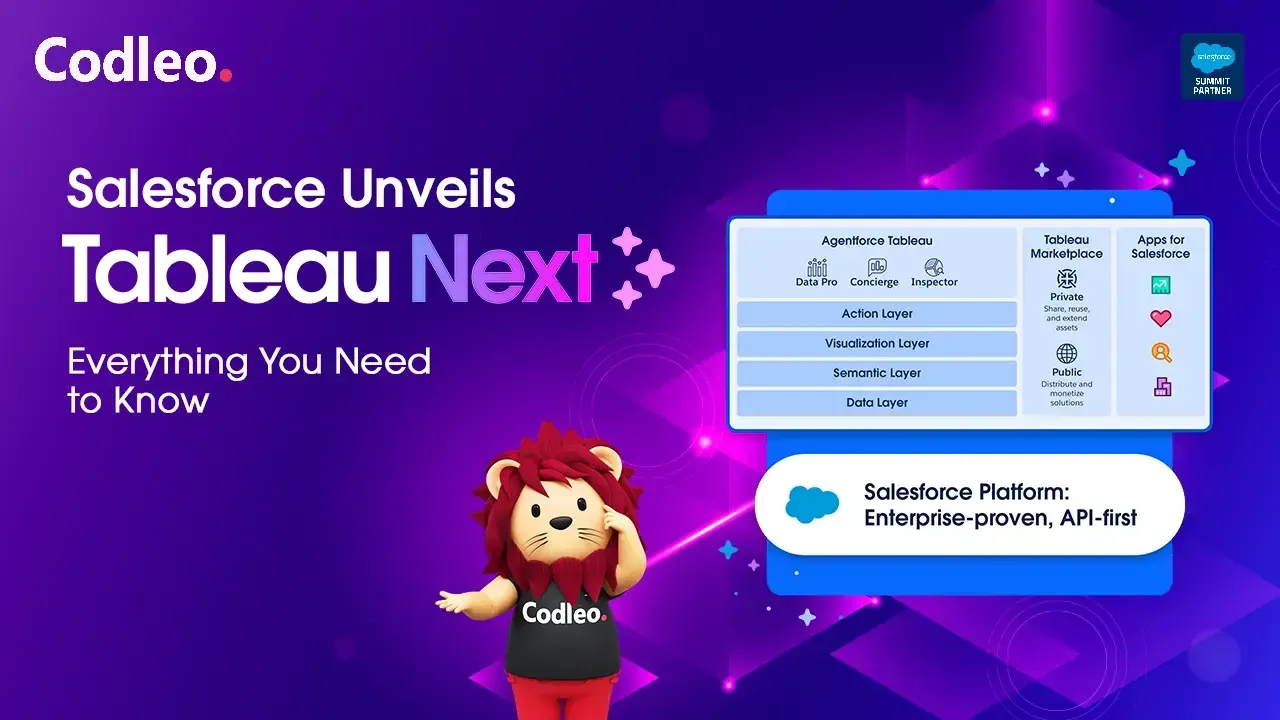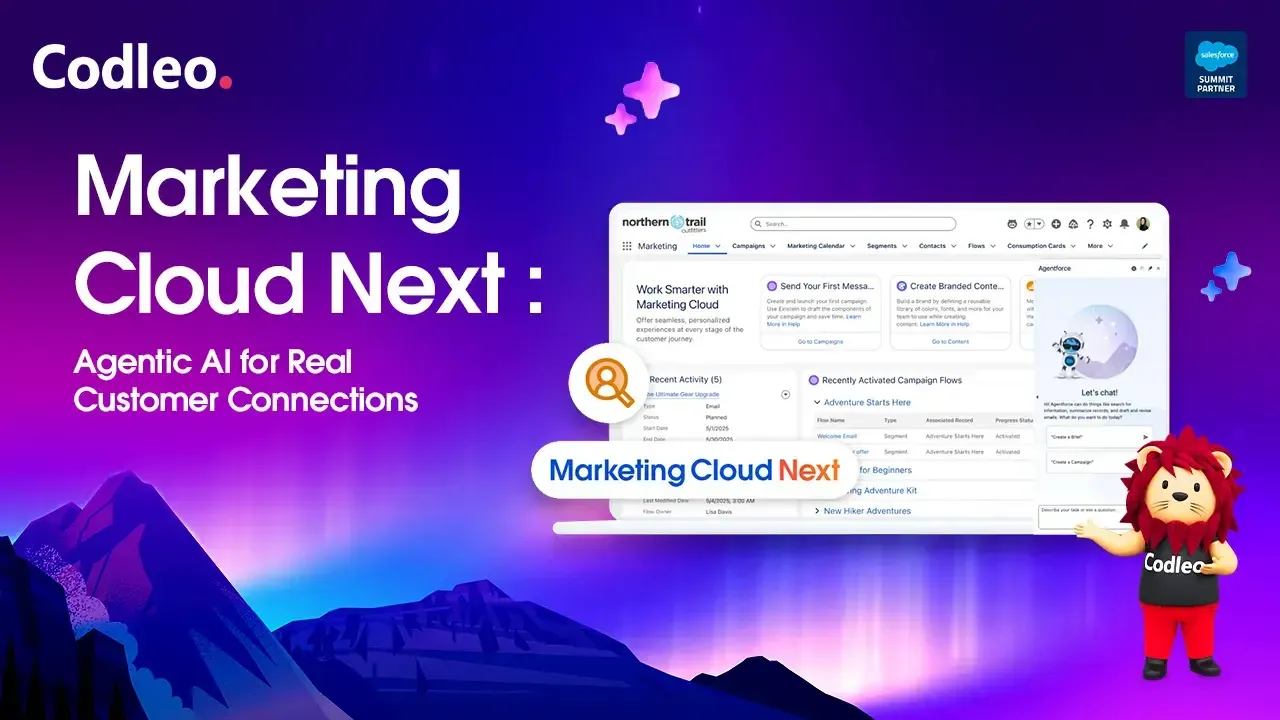Publish date:
Compare two top CRM systems: Zendesk and Salesforce. Evaluate their main features, scalability, and ease of use. Determine which one is better suited to your needs. You can also learn how to move from Zendesk to Salesforce or how to connect Zendesk with Salesforce to get the most out of both systems.
Take a quick look at this Zendesk vs Salesforce comparison chart:
Zendesk vs. Salesforce Comparison Chart
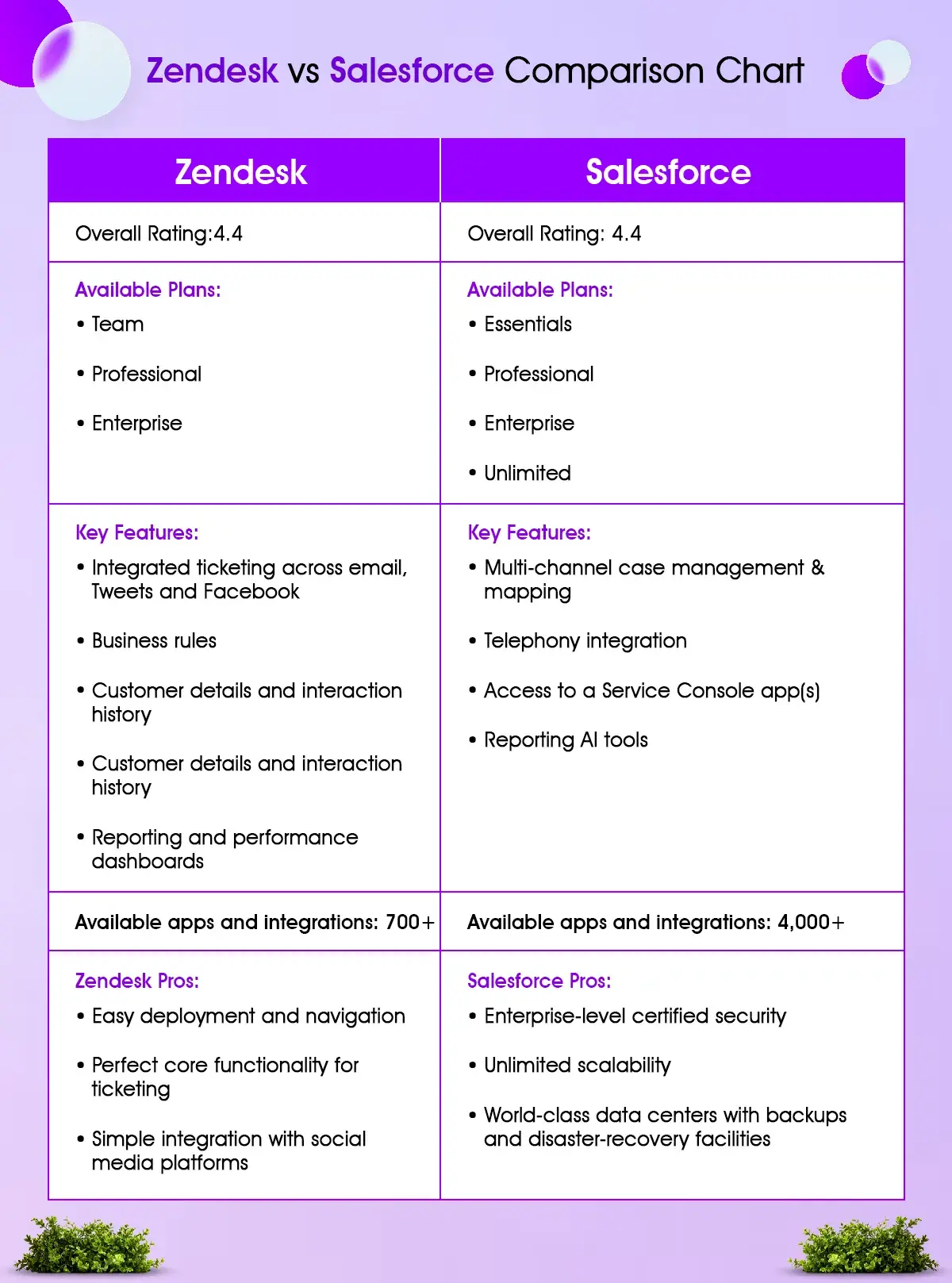
Now, read a brief introduction to these two platforms.
What is Salesforce?
Salesforce is a company based in the US that provides software and platform services. It was founded in 1999 by Halsey Minor, Parker Harris, and Marc Benioff. The company is located in San Francisco.
The top Salesforce clients include Spotify, Toyota, American Express, Canon, and L'Oréal, as well as over 150,000 small to large businesses worldwide.
Salesforce ended 2021 with an annual revenue of $21.25 billion. It makes the company a leader in creating customer relationship management systems. These systems help improve sales, service, and marketing for various industries, including financial services, healthcare, and manufacturing.
Number of Employees: 35,000
Salesforce offers several key products and platforms, including Sales Cloud, Service Cloud, Marketing Cloud, Experience (formerly Community Cloud), Einstein Analytics, and AppExchange.
What is Zendesk?
Zendesk is a cloud customer support software company founded in 2007 in Denmark by Alexander Aghassipour, Mikkel Asger Svane, and Morten Primdahl. The company later moved to San Francisco. In 2021, Zendesk generated $1.2 billion in revenue, positioning it as one of the top cloud software companies.
Number of Employees: 2,740
The largest clients of Zendesk include Netflix, Dropbox, Etsy, Accenture, Uber, MTV, and Tesco.
Zendesk offers several main products: Zendesk Service, Zendesk Sell, Zendesk Sunshine, and Zendesk Marketplace.
What Makes Zendesk and Salesforce Special?
Many companies store data in various locations, such as databases and online applications. It can make it difficult for users to gather all the necessary information for analysis.
When searching for new software, many individuals struggle to choose between Salesforce and Zendesk. Both of these companies offer a range of products that can help your business grow.
Zendesk Product Family Overview
Zendesk is a valuable tool for handling customer issues. It lets you keep all customer interactions in one place. With Zendesk, you can provide smooth, personal, and practical support.
Zendesk Support
Zendesk Support helps improve customer service and support. It enables teams to collaborate and communicate effectively across various channels. It also utilizes AI technology to enhance the customer experience.
Zendesk Sell
Zendesk Sell helps sales teams work more effectively and track their sales progress. It automates sales tasks and helps gather, analyze, and manage essential data using customizable dashboards.
Zendesk Sunshine
Zendesk Sunshine is a CRM platform built on Amazon Web Services (AWS). It connects different data sources and improves customer data.
Zendesk Marketplace
Zendesk Marketplace is an app store where you can find ready-to-install tools to improve your email marketing, social media, and document management.
Salesforce Ecosystem Overview
Salesforce Sales Cloud
The Sales Cloud is Salesforce’s first and most popular customer relationship management (CRM) platform. It helps organizations manage their sales. Initially, it was made for B2B (Business-to-Business) companies to guide potential customers through a sales process.
Now, B2C (Business-to-Consumer) companies can also use the Sales Cloud.
Salesforce Service Cloud
Salesforce Service Cloud is a customer service tool. It provides a comprehensive view of your customers' questions, enabling you to communicate quickly and personally.
Salesforce Marketing Cloud
The Marketing Cloud is a powerful digital marketing platform designed for B2C marketers. With it, you can:
-
Connect with your customers
-
Track the customer journey across various communication channels
-
Manage your social media, email promotions, digital advertising campaigns, content creation, and data analysis.
AppExchange
AppExchange is Salesforce’s online marketplace for third-party applications. These apps are developed by independent software vendors and hosted on the Force.com platform. It works like the App Store and Google Play: you can download and install apps to enhance the Salesforce CRM platform.
Now, let’s answer the central question of this post: “How does Zendesk compare to Salesforce?” We will explore this from different angles to help you make an informed choice.
Zendesk vs Salesforce: Which Fits Your Organisation Best
We compare Zendesk and Salesforce based on their ratings, pricing plans, system reliability, features, customer service, and other key factors.
Rating
Salesforce and Zendesk have similar ratings on review sites like TrustRadius, Capterra, G2.com, and GetApp. Overall, customers are happy with both platforms.
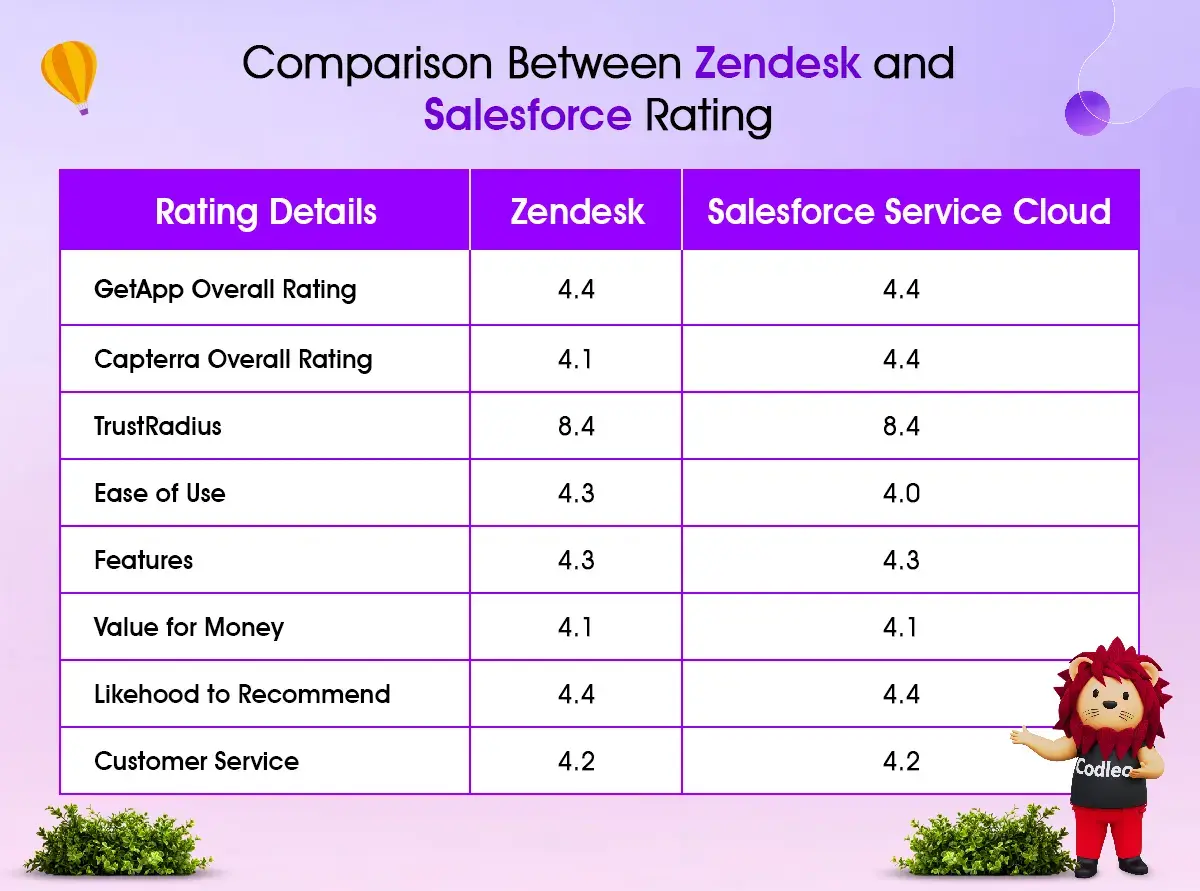
Pricing
From the outset, it is evident that these two options differ significantly. The pricing levels vary greatly based on the features provided.
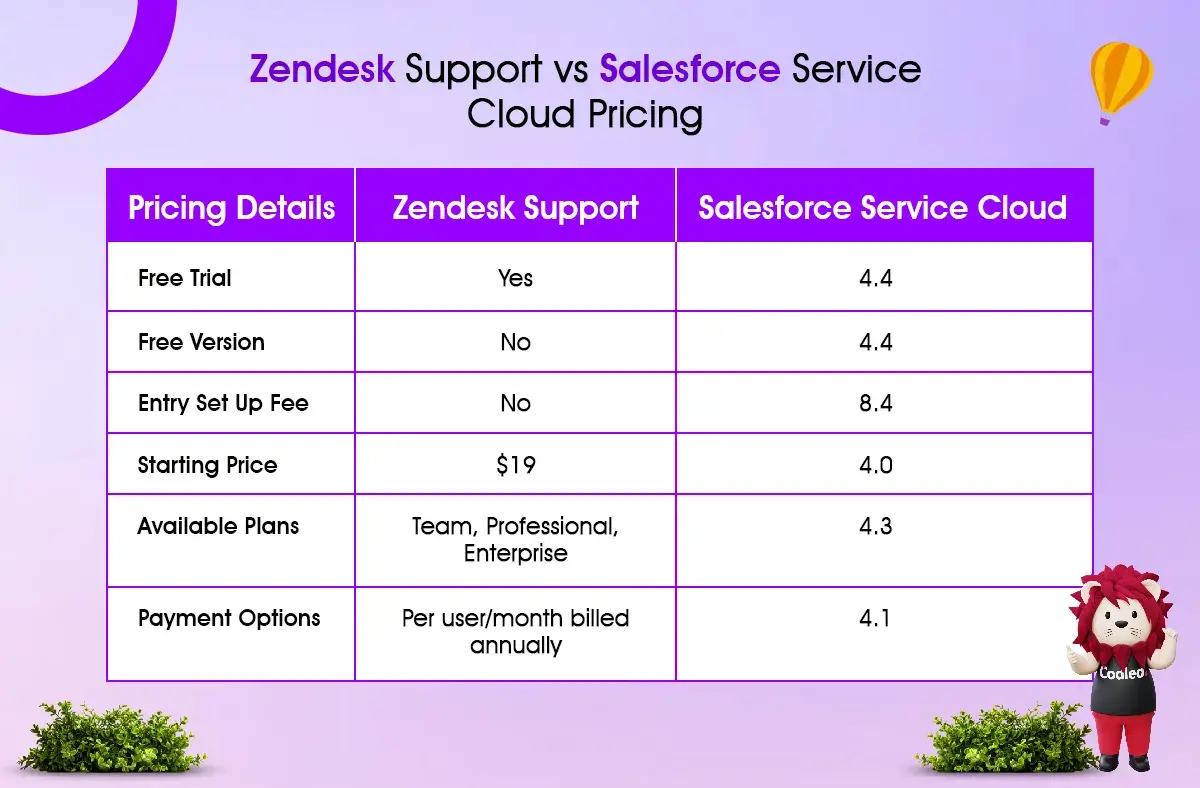
Comparison of Salesforce Service Cloud and Zendesk Pricing
The cheapest plan in Salesforce Service Cloud costs $25 per user. In comparison, Zendesk offers a lower price at $19 per user.
The starting plan of the Service Cloud enables you to create your help center and provides access to all the necessary channels.
Zendesk and Salesforce show their prices as annual subscriptions. There is no free version available for either tool; however, both offer a free trial, allowing you to try them out.
Salesforce Zendesk and Salesforce pricing pages can be confusing. Salesforce offers various plans for Service Cloud and Sales Cloud, ranging in cost from $25 to $300 per user per month.
Salesforce Service Cloud Pricing Comparison
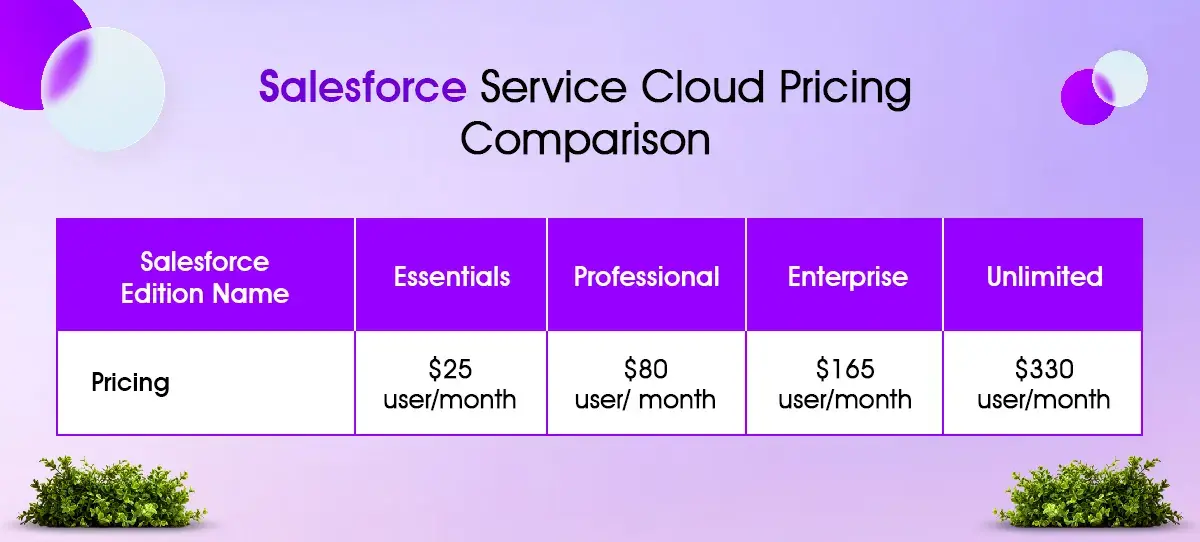
Salesforce Service Cloud Editions Pricing Overview
Salesforce offers four pricing plans: Essentials, Professional, Enterprise, and Unlimited. The Essentials plan starts at $25 per user each month if billed annually.
You can create your help center with the basic plan. To assign roles to software users, you need to choose a more expensive plan. For Sales & Service Cloud, the cost ranges from $25 to $325 per user per month.
Zendesk Sell Plans Pricing Comparison
Overview of Zendesk Sell Plans Pricing
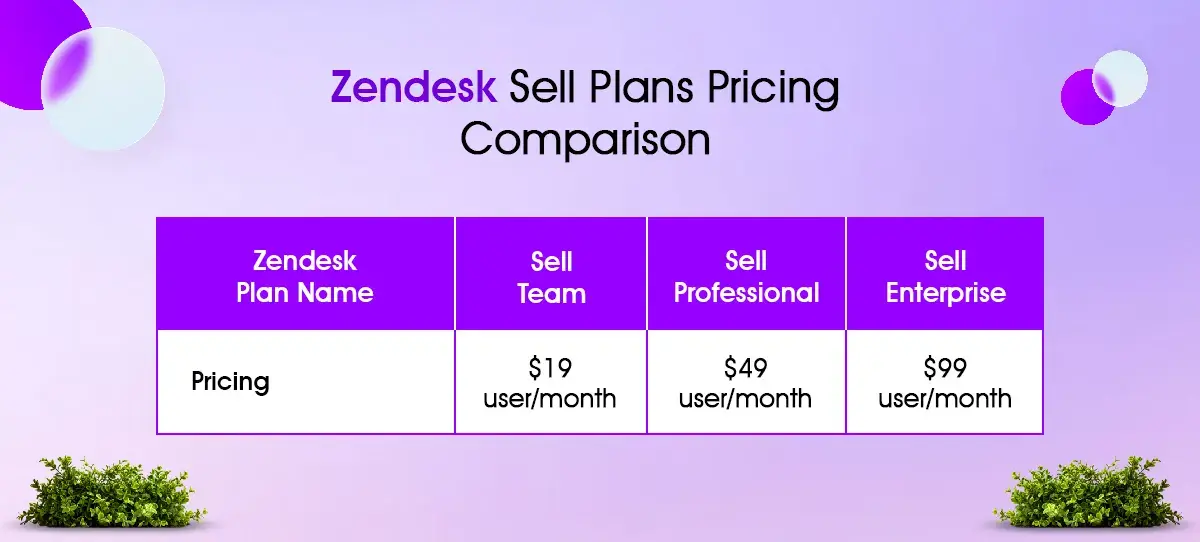
Zendesk Support plans pricing ranges from $19 to $99. There are three available suites: Support Team, Support Professional, and Support Enterprise.
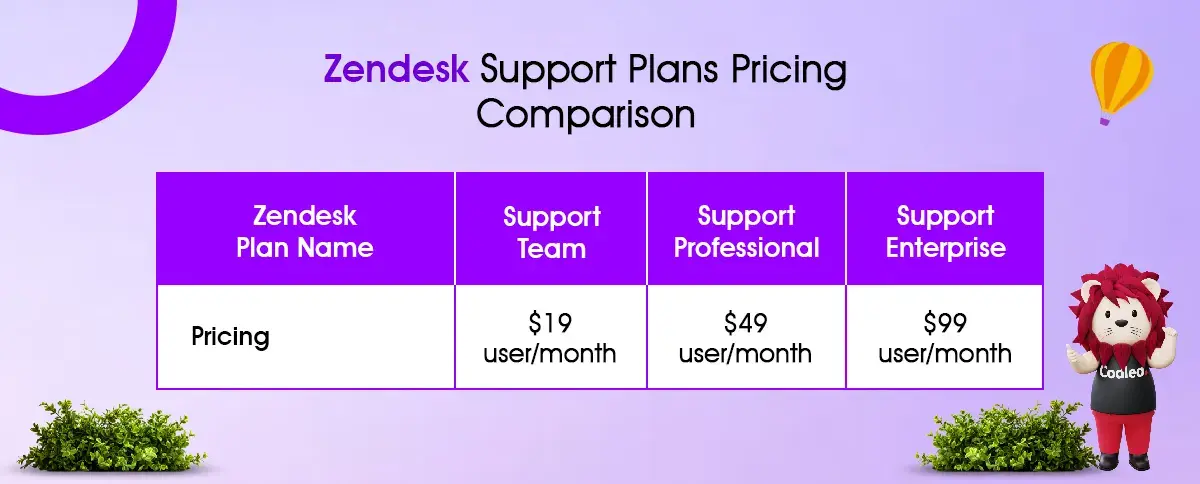
Overview of Zendesk Support Plans Pricing
The Support Plan has limited features, even for small businesses. It does not include live chat, SMS, voice messages, or support for WhatsApp, WeChat, Twitter Direct, and Facebook Messenger.
With a Support Suite, you can create self-service portals, like a help center, for your customers. There are essential differences between the Professional and Enterprise plans. The Enterprise plan provides 24/7 support, the ability to customize the chat widget, and options for various user roles and permissions.
Zendesk Suite Plans Pricing Comparison
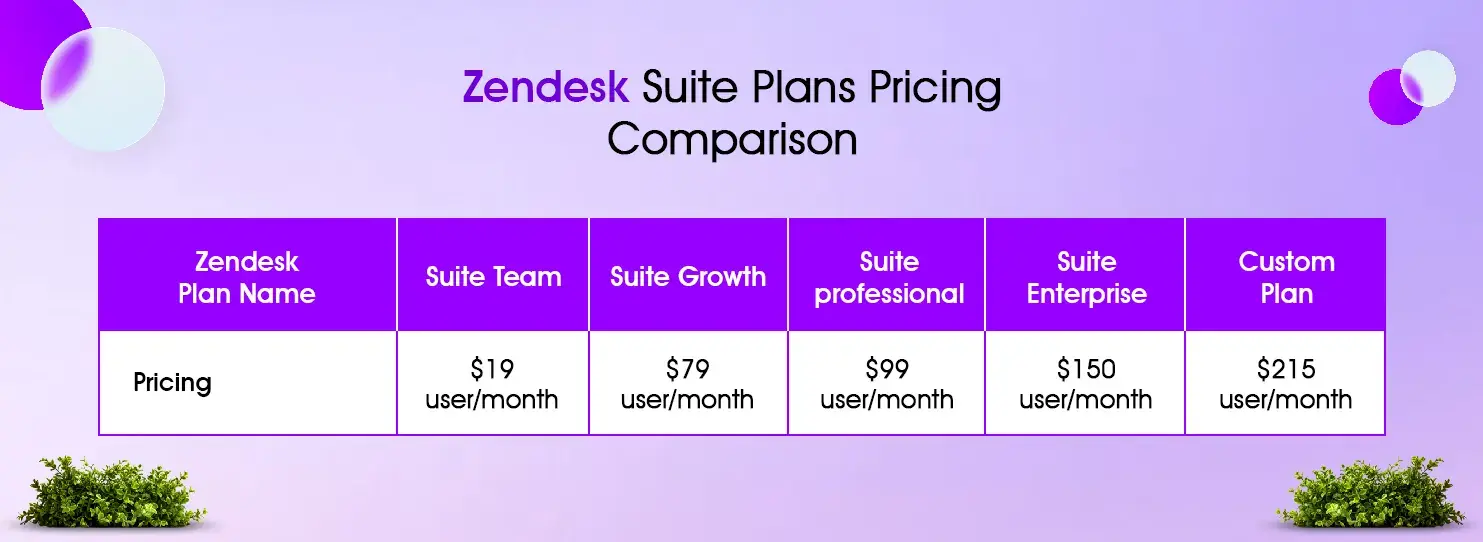
Overview of Zendesk Suite Plans Pricing
Interface
Zendesk has the best interface. It has a modern design that is easy to set up and use. You won’t need to customize it much. You can easily navigate through the tabs, and new support team members will have little trouble learning how to use it.
Salesforce Service Cloud can feel overwhelming for beginners. When you log in, it seems like there’s too much to take in.
However, the system guides you through a series of tasks to help you learn how to use it.
The number of options can be overwhelming, and it may take your agents time to understand the solution. However, once we make the necessary adjustments and customizations, the software will be very effective for you.
That’s why it’s best to hire a full-time developer and work with a Salesforce consultant to make it a fully functioning tool.
System Security & Reliability
Salesforce and Zendesk are cloud-based software solutions. You can access them securely from any internet-enabled device anywhere in the world.
Salesforce provides robust security features for large enterprises. Users appreciate that they can set up access so only devices from trusted IP addresses can enter the system at specific times.
Zendesk customers appreciate that it has minimal downtime.
Salesforce Service Cloud vs. Zendesk Features
Let’s go through the functionality to find out what you are going to pay for.
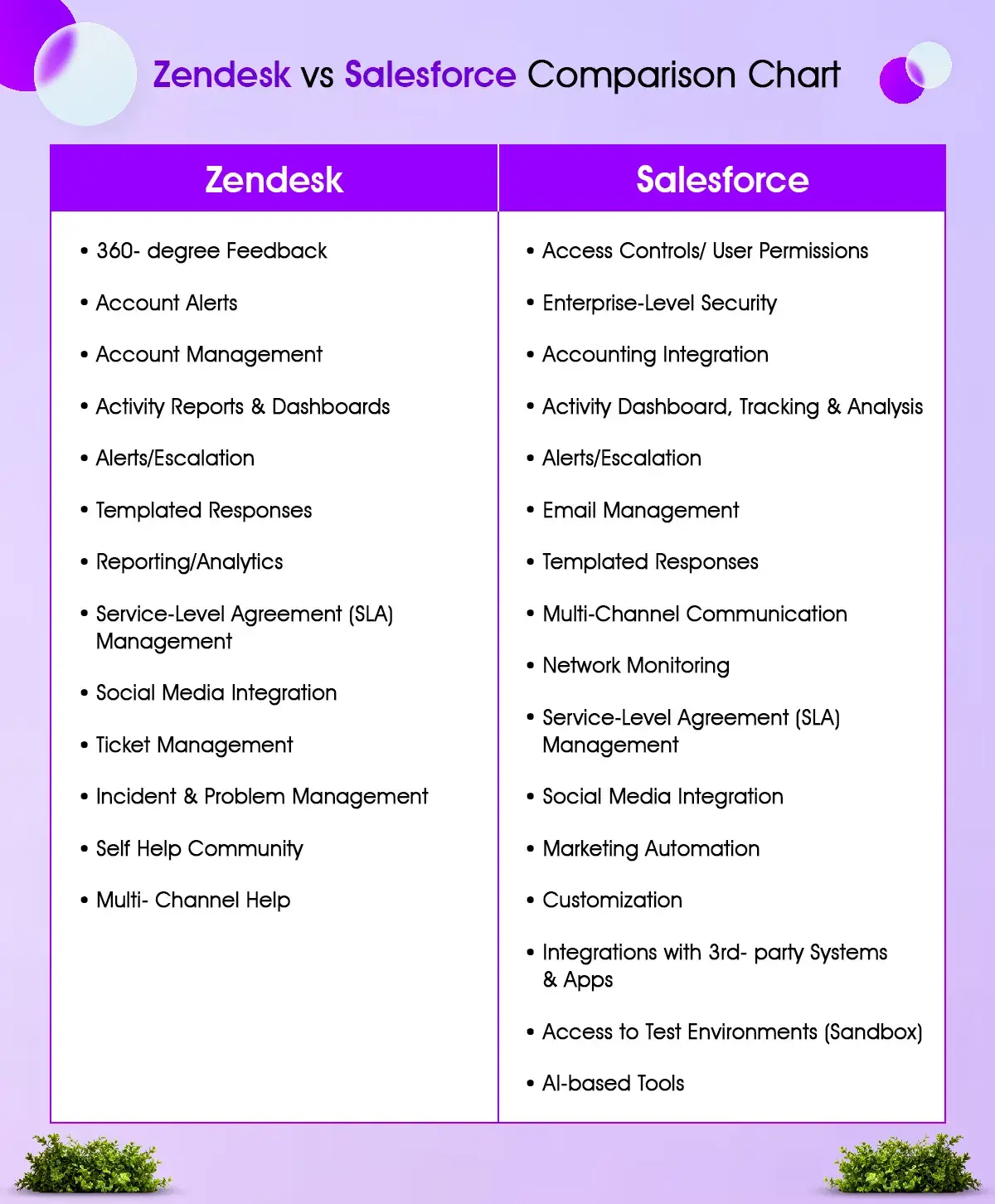
Zendesk vs. Salesforce Features Comparison
Zendesk vs. Salesforce Features Overview
The Zendesk ticket management system is a powerful and feature-rich solution. You can easily manage ticket workflows, use different email templates, schedule tasks, and automatically assign tickets to customers.
Managing tickets with Zendesk is easy. When a user contacts the company by phone, email, chat, or social media, the software turns the message into a single ticket format.
The Zendesk issue tracking system, along with detailed reports and automatic ticket sharing, can make things much easier.
Zendesk focuses on sales and service operations, offering a straightforward set of features. However, it does not provide solutions for marketing activities.
In Salesforce Service Cloud, cases are not organized in the same way as tickets. The system uses AI to assign cases to the right support teams for resolution.
A timeline will display the complete history of customer interactions, providing support engineers with the necessary contact information.
Salesforce Service Cloud provides tools to help you track key information, including the number of leads, conversion rates, and sales forecasts. It makes managing leads, opportunities and deals easy within Salesforce.
You can use a report builder to create custom reports.
In comparing Salesforce and Zendesk, Salesforce offers a more comprehensive view of customers, enabling improved interactions and sales. Zendesk is easier to use but has more limited features.
CRM Implementation
Salesforce is a platform for more experienced CRM users. If you are completely new to CRM world, you need to seek external help to guide on proper Salesforce implementation.
Before moving your data to Salesforce, it's wise to get outside advice on how to organize and standardize it.
In contrast, Zendesk is easier to get started with. However, setting up single sign-on and integrating it with other systems can be a technically challenging task.
Scalability
Salesforce is recognized for its ability to scale and adapt to the evolving needs of large organizations. It can be tailored for any industry, company size, and business purpose.
On the other hand, Zendesk has limited scaling capabilities.
Return on Investment
Salesforce offers many features and capabilities. To maximize the benefits of these features, you may need to hire a consulting agency or an in-house expert who can help you unlock your full potential.
Companies require a customized plan that aligns with their specific needs when implementing Salesforce. If they don’t, their return on investment (ROI) may not meet expectations.
Zendesk has fewer features than some other options. However, you can set it up in about a day and start seeing quick results.
Customer Service
Both Salesforce and Zendesk do a great job of supporting their customers. Zendesk users note that support agents are friendly and respond promptly.
Salesforce users want round-the-clock access to support teams to resolve issues with Salesforce products.
They can also get quick help from other users on the Trailblazer Community portal.
Users can ask questions, answer others, and get advice on troubleshooting Salesforce problems.
Self-Service Center
Zendesk Guide enables agents to create a help center that supports multiple languages. If you opt for a more expensive plan, you can also establish a community and a self-service portal featuring your brand.
Salesforce Service Cloud lets you create a customizable portal or community with a knowledge base using the Lightning Community Builder.
Add-Ons and Integrations
Salesforce offers a wide selection of apps and extensions on its AppExchange, with nearly 4,000 available. There are apps for almost every need. For example, you can find an add-on specifically designed for commercial real estate. This app combines the power of the Salesforce platform with tools for the commercial real estate industry.
If you want to improve report generation or search through multiple records in Salesforce, you can also integrate Salesforce with other products like Field Services, CPQ, Billing, or Pardot.
On the other hand, Zendesk offers around 700 integrations, including options for social media, live chat, and phone systems.
Salesforce vs Zendesk Data Analytics
When comparing Zendesk and Salesforce for data analytics, Salesforce is a better choice. It provides not only standard reports and dashboards but also additional features.
-
Forecasting reports in regards to customer preferences and sales
-
AI-based probability score
-
Drag and drop analytics capabilities
-
Automated customer details and history analysis.
Zendesk offers useful digital reports with basic features. In contrast, Salesforce provides more detailed and specific data analytics than Zendesk.
Data Export/Import Capabilities
Both solutions offer options for exporting and importing data. However, using them can be complicated, especially when trying to retrieve specific data, such as tickets or reports. It often involves coding and working with Comma-Separated Value (CSV) files.
However, in Salesforce, this challenge can be easily solved using advanced search and export tools available on the AppExchange. These tools allow users to effortlessly export filtered data from Salesforce to Excel without complex configurations or manual work.
With the right solution, you can quickly extract records, apply filters, and generate Excel files for reporting, analysis, or sharing — all within a few clicks.
Training
Both Salesforce and Zendesk provide various user training options:
-
In-Person
-
Live Online
-
Expert Webinars
-
Documentation
-
Video Tutorials.
Even with many training options available and Salesforce Premium support offering unlimited access to instructors and free online training, there are some downsides.
Zendesk users report that numerous resources are available for training, including videos, webinars, and articles designed to help individuals enhance their skills. However, it can be challenging to determine how to utilize these resources.
On the other hand, Salesforce training materials tend to focus more on new users than experienced teams and may not be suitable for large businesses or specific industries.
If you need advice specific to your area, such as commercial real estate, or if you require assistance with complex changes, it's advisable to work with a Salesforce consulting firm.
Zendesk vs. Salesforce Pros Summary
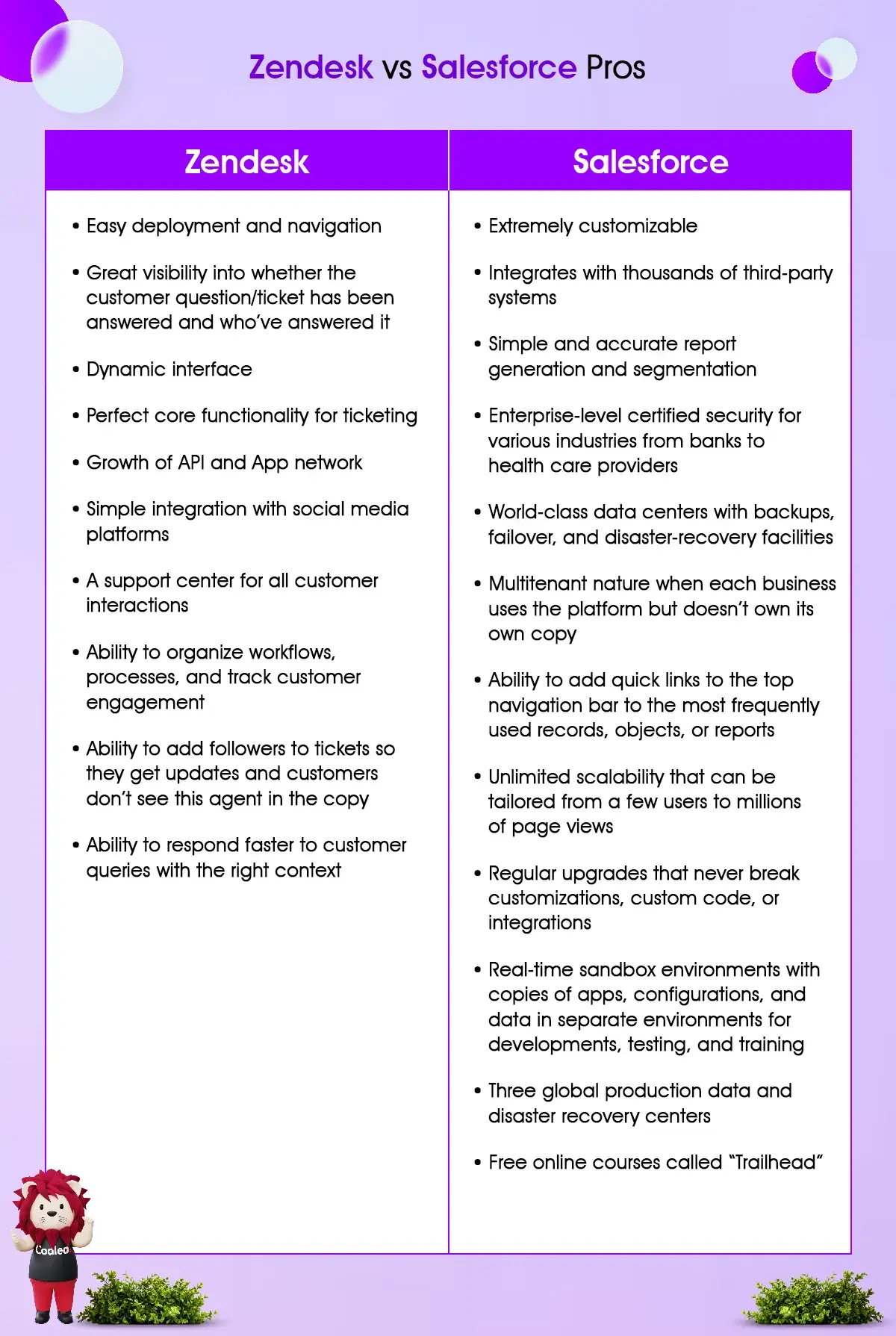
Zendesk vs. Salesforce Cons Summary
Zendesk Sell vs. Salesforce Sales Cloud
Let’s quickly compare two other popular Zendesk and Salesforce products: Zendesk Sell vs Salesforce Sales Cloud.
Zendesk Sell
You can move or turn off dashboards in Zendesk Sell. The system includes key data items: Leads, Contacts, Deals, a Calendar, Tasks, a Communication Center, and Reports.
Everything starts as a Lead. You can convert a Lead into a Contact with an Account, and the Deal represents the product or service you sell.
The interface is simple to use, and you can add notes as needed. You can also send emails and text messages.
Zendesk Sell offers a marketing automation program called Reach. With Reach, you can send nurture emails to leads, prospects, collaborators, and others involved in a deal. You can also easily manage upcoming appointments and tasks, as well as attach documents.
Zendesk Sell provides analytics that shows whether an email has been opened, when it was opened, and how many times it has been viewed. It can work well with your email client. You can view the complete email history and use a template to create a message. You can also include merge tags, such as the recipient’s first and last name, company, and any other information stored in the database.
Zendesk Sell can work with tools like QuickBooks Online. When you send a message to a customer, you can view their full invoice, quote, and sales order details.
In Zendesk Sell, you can set up multiple pipelines. It is helpful for account executives and sales representatives who work on cross-selling. On a company page, you can access all the essential information about the company.
Zendesk Sell works well with Zendesk Support. When a contact becomes a customer and submits a support case, the ticket will be updated in Zendesk Support and will appear on the company tab.
Zendesk Sell features a Client Space where you can collect data and collaborate with others. This space helps you share your progress and ideas about a deal or opportunity. Zendesk Sell also features phone integration, enabling you to make calls directly from your browser.
Salesforce Sales Cloud
In the Salesforce Sales Cloud dashboard, you can customize and rearrange your view. You can adjust your navigation to suit your needs.
Everything begins as a Lead, and you'll see a progress bar at the top. It encourages users to complete specific fields and tasks before converting the lead record.
You can log a call in Salesforce, but you will need a third-party integration to sync it. You can also create tasks and events and link your email in the same way.
In Salesforce, you can create an email or drag a template into the system and send it directly from the CRM.
When you convert a Lead, you will need to search for an existing account or create a new one. This process helps to avoid duplicates. In Salesforce Sales Cloud, you can see small pop-ups that show a summary of information when you hover over areas in the sub-panel.
In the right-side panel, you can also create, track, and manage new tasks, events, and emails.
Zendesk Salesforce Integration: Key Benefits and Limitations
If you use Salesforce and want to integrate features from Zendesk, such as ticket management, you may have some questions. You might ask: “Does Zendesk work with Salesforce?” “What are the benefits of Zendesk and Salesforce working together?” and “How does Zendesk connect with Salesforce?”
Does Zendesk integrate with Salesforce?
Yes, you can integrate Zendesk Support with Salesforce Sales, Service, and Marketing Clouds.
How does Zendesk sync with Salesforce?
You can connect Zendesk Support with Salesforce by either installing the Salesforce for Zendesk Support app from the Zendesk Marketplace or by using an integration app, such as Zapier or Workato, from the AppExchange.
What are the Benefits of Salesforce Zendesk Integration?
It allows Zendesk tickets to be viewed in Salesforce from the Account, Opportunity, Lead, or Contact page.
Two-way customer information synchronization
The Zendesk Salesforce integration keeps all customer data in one place in Salesforce and updates it in real time. It lets you share customer information from Salesforce to Zendesk Support and automatically updates the data.
No language barrier
You can easily integrate Zendesk with Salesforce, regardless of language. This integration allows you to customize its features to fit your business needs.
Seamless access to customer issues and questions
In Zendesk, you can access any Sales Cloud data, including customer information. It allows you to display a complete Salesforce customer profile alongside a live ticket.
Your sales team can view, create, and edit Zendesk tickets without leaving Salesforce. Managers can also include Zendesk ticket data in their Salesforce reports.
For example, you can build a new reporting dashboard in Salesforce that filters Zendesk ticket data using Sales Cloud views.
Centralized communication on the work items
The integration connects sales and support teams by creating a unified customer database that remains up-to-date. Sales representatives can access customer information, such as wait times, and participate in the support process.
You can keep all customer data synchronized and work from one set of records. This setup allows you to compare sales data with Zendesk support data.
The integration of Zendesk with Salesforce enables sales and support teams to collaborate more effectively by providing them with visibility into customer data and actionable insights.
In-time notifications when a customer issue is resolved
Your teams can easily view Zendesk tickets in their Salesforce accounts. You can also check the average time it takes to resolve support tickets for key accounts during a sales cycle.
The Zendesk and Salesforce integration enhances communication and streamlines workflows for your sales and support teams. However, this integration has both benefits and limitations.
Limitations of Zendesk with Salesforce Integration
Not all integrations can do every task. It's important to know that this integration has some limitations and does not support:
-
Personal accounts in Salesforce require a corporate account
-
Salesforce organizations without API rights
-
Salesforce integration on Streamline APIs
-
Salesforce hierarchical structure doesn’t retain in Zendesk
-
Zendesk faces challenges in data export.
What You Can Integrate in Salesforce and Zendesk
Zendesk and Salesforce integration allows your support team to access sales data easily. It creates one customer database that connects sales and support, keeping both teams updated and in sync.
You can create Salesforce reports that include data from Zendesk. The Salesforce and Zendesk integration provides real-time information about support and sales teams, their activities, and priorities. By combining these two solutions, you can help teams work more effectively, resolve customer issues more quickly, and improve customer communication.
The Zendesk integration for Salesforce is adaptable. It lets you select the specific features that work best for your business.
By integrating these two solutions, you can:
-
Send Zendesk tickets to Salesforce
-
View Zendesk tickets using Account, Contact, and Lead VisualForce Pages
-
Choose which features you need and customize them to work for your Salesforce setup
-
View Salesforce data in Zendesk
-
View Zendesk tickets in Salesforce
-
Create and edit Zendesk tickets in Salesforce
-
Send Zendesk tickets to Salesforce.
You can also do more advanced tasks like syncing Salesforce accounts with Zendesk organizations or syncing Salesforce contacts and leads with Zendesk users. However, please check with Zendesk to determine if these features are compatible with your customized Salesforce setup.
Here are the most frequently asked items to be connected:
-
A User / Agent in Zendesk with a New Contact in Salesforce
-
A Ticket in Zendesk with a New Custom Object in Salesforce
-
A User / Agent in Zendesk with a New Lead in Salesforce
-
A Note in Salesforce with a New Ticket in Zendesk
-
A User / Agent in Zendesk with a New Custom Object in Salesforce
-
A Ticket in Zendesk with a New Lead in Salesforce
-
A Ticket in Zendesk with a New Contact in Salesforce
-
A Custom Object in Salesforce with a New Ticket in Zendesk
Integration Requirements
Ensure you meet all the requirements in Zendesk and Salesforce before installing Zendesk for Salesforce.
Zendesk Requirements
You can use the Salesforce integration with Team, Professional, and Enterprise plans.
If you are using Zendesk’s host-mapping feature, ensure that you also set up hosted SSL.
Salesforce Requirements
Your Salesforce organization must be on the Enterprise, Unlimited, or Developer edition (or have Salesforce API rights) to use Zendesk for Salesforce integration.
The package needs API rights, which are available to customers with Salesforce Unlimited and Enterprise editions. Customers using other Salesforce editions must get API rights separately.
Why compete? Integrate Zendesk with Salesforce
Salesforce is a leader in the industry, and combining it with Zendesk can provide your customers with the best possible experience. It's not just about getting new customers; it's also about keeping them happy. Zendesk is the top choice for customer experience and engagement.
The integration of Zendesk with Salesforce is designed to be flexible and adaptable. You can tailor it to meet your specific needs as your business grows.
Conclusion
There is no clear winner in the comparison of Zendesk and Salesforce. It depends on each organization’s priorities and needs to decide which option is better for them.
Zendesk is a helpful support software that offers good tools for customer interaction. It is easy to set up and manage. Zendesk is well-suited for small companies that require a straightforward solution.
Salesforce is excellent for managing customer interactions and providing a comprehensive view of the entire customer journey. However, it can be complicated for new users and small businesses.
You can simplify the process by installing an add-on to connect these two solutions and enhance their basic features.
Still unsure which platform is right for your business? As a trusted Salesforce Partner, Codleo is here to guide you every step of the way. With our expert Salesforce consulting services, we help organizations select, implement, and optimize the ideal customer service solution tailored to their specific goals.
Schedule a free consultation today and let Codleo empower your customer support journey with the best-in-class Salesforce solutions.
FAQ
Salesforce Service Cloud is more complex and offers a range of features to meet the diverse needs of all customers. Zendesk is more straightforward and uncomplicated.
You can migrate from Zendesk to Salesforce Service Cloud by doing it yourself, using migration tools, or hiring CRM migration services.
Yes, you can integrate Zendesk with Salesforce by installing an app from the Zendesk Marketplace or using integration apps like Zapier or Workato from AppExchange.
No, they are different. Both Salesforce and Zendesk are in the CRM market; however, Salesforce is a platform-as-a-service (PaaS), while Zendesk is a software-as-a-service (SaaS) solution. Salesforce is versatile, while Zendesk focuses more on service and sales automation.








